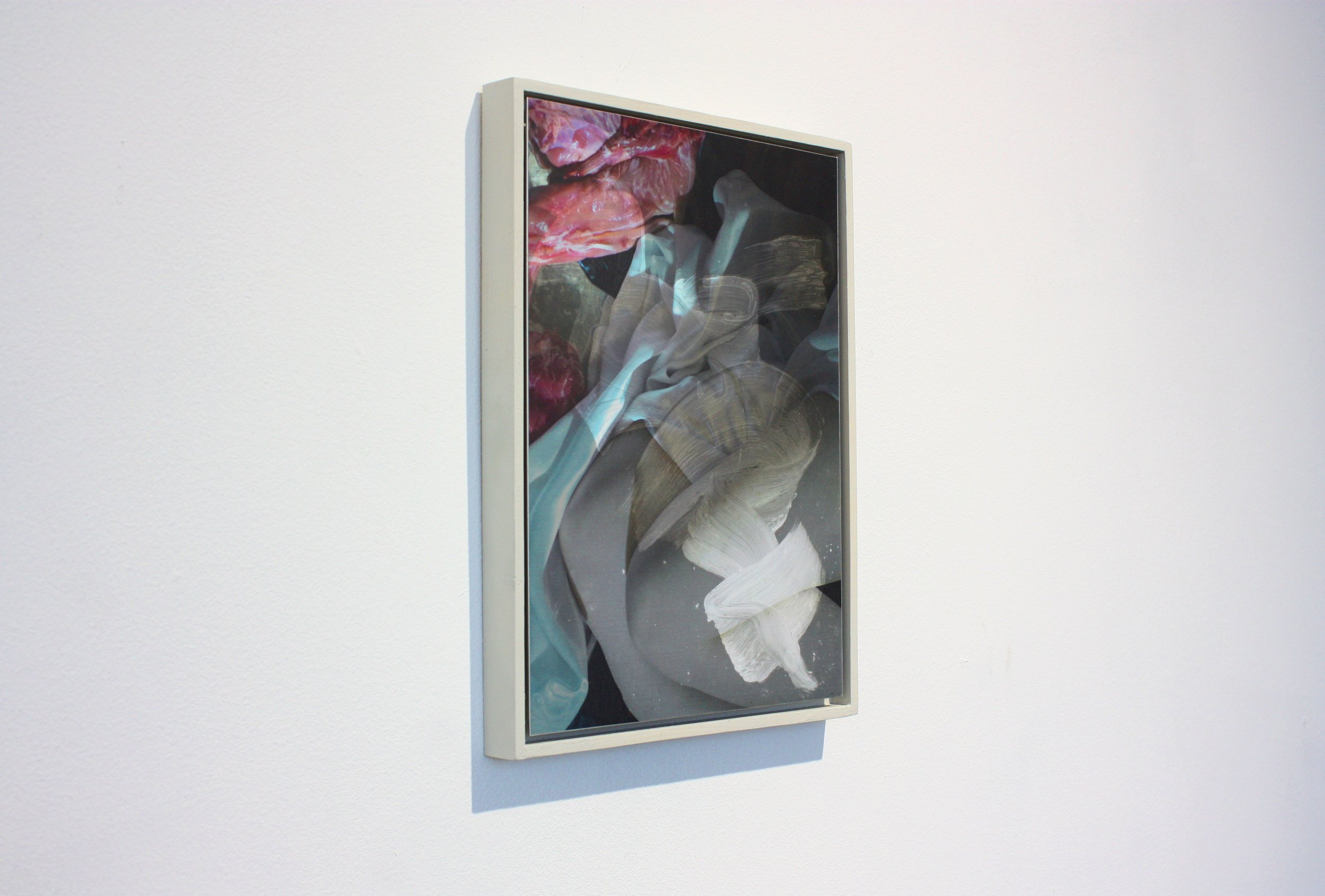Natureza Morta/2022
La Petite Mort, 200 x 80cm , mixed media on aluminium
Natureza Morta is part of my ongoing photography/photo-collage series using mirrors in which I use my own body to create a contemporary memento mori and explore the idea of the fragmented self. This piece from my 'Natureza Morta' is inspired by the classical tradition of the reclining nude, as well as dutch still life painting. Every item in the image is laden with symbolism both historical and contemporary. Some retain their original meanings, whilst others are turned on their head: The Custard Apple for example, refers to eve, original sin and the ‘dangers’ of female sexuality; the peach is a commonly used emoji in text conversations, and the rabbit, traditionally a symbol of fertility and hope is presented to us here skinned and foetus like placed next to the hips.
Natureza Morta II, 140 x 88cm, mixed media on aluminium - detail
Fruit of my Loins , 25 x 35cm , mixed media on aluminium
LA PETITE MORT 2022 by Dr. Marie-Anne Mancio
Fontaine-Wolf’s ‘La Petite Mort’ references Dutch still life painting, or what the Portuguese call natureza morta. The latter was such a popular genre in the sixteenth and seventeenth centuries that painters were able to specialise. There were tonal still lifes, for instance, or Pronkstilleven - elaborate still lifes -
of which Fontaine-Wolf’s ‘La Petite Mort,’ is one. These were always contradictory. With their seductive surfaces – be it the glint of a silver platter or the drop of water on a silky petal – Dutch still lifes encouraged the viewer to indulge in material possessions at a time when the Dutch East India company was transporting ever more exotic items: pepper from Java; turkey from the Americas. Yet, they admonished the viewer too for neglecting the spiritual life, warning that pleasure – food, sex – was only temporary. Memento mori (“remember you must die'' in Latin) they proclaimed, hence the presence of hourglasses, skulls, or candles burnt to a nub. Often, death is already visible: a leaf wilts; a worm burrows into an apple. Here the classic supine nude, so beloved of classical painters and sculptors, is the banquet that is rendered as lifeless as the carcasses and the plucked fruit that surround her. There are echoes too of Fuseli’s ‘Nightmare’ 1781 - a painting that has come to epitomise the Romantic movement with its emphasis on nightmares, the supernatural. In it, a virginal sleeper is unable to move, an incubus pressing on her chest and a stallion bursting through curtains. Allegedly about women’s tendency to suffer strange dreams when they are pre-menstrual, the painting has a sexual charge and the terror of sleep paralysis (which Fontaine-Wolf suffers from).
Fontaine-Wolf’s image is a study in formal elegance: there are the subtle compositional echoes – the eye of the skinned rabbit at the lower left echoing the artist’s nipple at the edge of the mirror’s frame; the grape-green of her loin cloth. The blue pink meat, the creased white cloth add a Baroque grandeur to an eerie scene. Figure and meat create a shape like an oyster shell, a famed aphrodisiac, attribute of Venus, and symbol of female genitalia. Fontaine-Wolf also incorporates a more contemporary symbol for female erogenous zones in the peach. Hers is a work rich in symbolism where objects have multiple meanings, secular and religious. As we delve into these (the custard apple recalling Eve, The Fall; the medlar - sex work because the fruit wasn’t considered edible until it had already begun to rot) we are reminded again and again how women’s sexuality was feared.
The post-coital mood of the work is implied also in its title, ‘La Petite Mort,’ a play on the French description for the semi-conscious state post-orgasm. Grapes recall not just the sacrificial vine but excess, wine, temptation, lust. Even the bread – the body of Christ – if left untouched imply salvation has been rejected in favour of lust. The lily, a symbol of purity, associated with the Virgin and visible at the Annunciation, is a funeral flower too: birth and death in one. And in fact, the rabbit, usually a symbol of hope and resurrection, is skinned and foetal in Fontaine-Wolf’s image, clutched close to the abdomen like a lost child. There’s a profusion of scattered feathers like a disturbed version of the still lifes with hunting motifs that graced wealthy Dutch dining rooms.The feathers hint at a violence beyond the frame. But it’s not clear if the body we see, with her blood-red fingernails, is predator or prey.
The Banquet, 100 x 60cm, mixed media on aluminium
Berardo Collection Acquisition
The Banquet, has been acquired by the Berardo Collection, one of the most significant collections of modern and contemporary art in Europe. Founded by José Berardo, the collection features iconic works by artists such as Picasso, Miró, Mondrian, and Warhol, spanning major movements like Cubism, Surrealism, and Pop Art.
"Banquet" employs my unique physi-digital technique, integrating painting, photography, and printmaking to merge the reclining nude with Dutch still life imagery. This fusion highlights societal gender norms and the objectification of women, by transforming the body into another object in the banquet, alongside meat, fruits, feathers, and mirrors.
Each item acts as a symbol with layered meanings. Flowers, such as lilies, intertwine themes of sexuality and death; the apple evokes original sin, while the peach—now a contemporary symbol thanks to emojis—adds a modern dimension. Meat reflects mortality and objectification, and the rabbit, typically associated with hope, is presented in a foetal, skinned state. Feathers hint at unrest, and the body, positioned in a classic pin-up pose with blood-red nails, challenges the boundary between predator and prey.
This symbolism reverberates with the themes of life and death often found in Dutch still lifes whilst prompting contemplation on society's deep-seated anxieties and contradictions surrounding the female body.



















